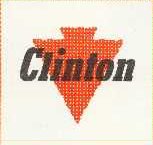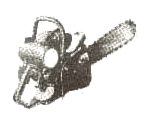HISTORY — CLINTON ENGINES CORPORATION |
|---|
| (Source: Clinton Field Service Manual [6166 From No. S-1213-1]) |
Overview |
 The first Clinton Engines factory was established in 1946 to manufacture small general-purpose air-cooled gasoline engines. It was first located in Clinton, Iowa, where 150 employees started producing a 1.5-horsepower engine. Initial production was approximately 225 engines a week. By 1947, the company had approximately 1,000 employees. The first Clinton Engines factory was established in 1946 to manufacture small general-purpose air-cooled gasoline engines. It was first located in Clinton, Iowa, where 150 employees started producing a 1.5-horsepower engine. Initial production was approximately 225 engines a week. By 1947, the company had approximately 1,000 employees.
In 1948, two additional models were added to the line — one a 2-horsepower engine; the other, a 3-horsepower engine.In 1950, Clinton purchased a 200,000-square-foot manufacturing facility in Maquoketa, Iowa, built five years previously for a manufacturer of farm equipment. Since then the plant has been enlarged to 250, 000 square feet. From the original 1.5 horsepower, 4-cycle engine Clinton now makes a total of 16 basic models ranging from 2 1/2 to 10.3 horsepower, of 2-cycle and 4-cycle design, horizontal and vertical crankshaft. During the company’s operation, it was one of the largest suppliers of these engines. Although Clinton engines were used principally on power lawn mowers, hundreds of original-equipment manufacturers used Clinton engines on their power equipment. Among the thousands of applications in which Clinton engines played a vital role were garden tillers, paint sprayers, post-hole augers, tractors, well-drilling equipment, rail-spike hammers, sprayers, compressors, emergency generators, and many other areas for home, industry, and agriculture. One of the largest outlets for Clinton engines was the power lawn mower market — an estimated two-thirds of the corporation’s engines went into this field. In addition, Clinton also produced complete lines of chainsaws and air-cooled outboards from 3 to 9.9 horsepower engines at the Maquoketa, Iowa, plant. Clinton engines were sold and serviced by more than 12,000 dealers in the United States and had 88 outlets in foreign countries. InnovationClinton was the first in the industry to:
Highlights
In 1953, Clinton entered the export market. In later years, Clinton accounted for one-third of all air-cooled engines sold under 10 horsepower overseas. In 1957, Clinton introduced its own line of 5-horsepower air-cooled outboard motors. Ideal for fishing, trolling and cruising, they could provide stand-by auxiliary power for small and medium-sized sailboats, as well as for dinghies, canoes, or any type of wood, fiberglass or aluminum craft. In 1966, a 9.9-horsepower air-cooled unit was added. In May 1966, Clinton received the coveted “E” Award for excellence in export from the President of the United States, the first engine manufacturer to be so honored. |
Clinton


 In 1952, Clinton introduced its own line of chain saws. The saws were used in agriculture, home construction, and by utility companies for clearing land, landscaping, and cutting timber and pulpwood.
In 1952, Clinton introduced its own line of chain saws. The saws were used in agriculture, home construction, and by utility companies for clearing land, landscaping, and cutting timber and pulpwood.